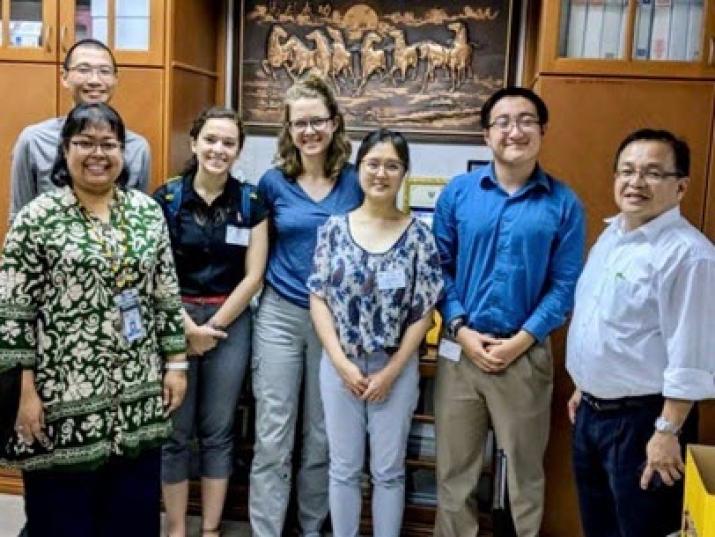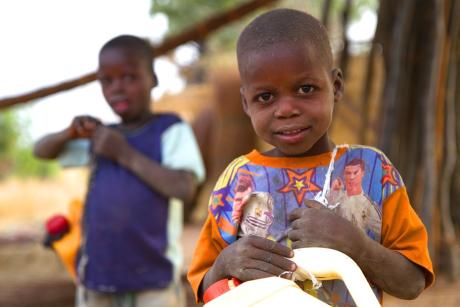
(L to R): Dr Jeffrey Soon Yit Lee (Senior Pediatric Medical Officer and one of our main collaborators at Sibu Hospital); Dr. Deburra Peak Ngadan (Acting Sibu Divisional Health Officer; Duke students Gina Kovalik, Julie Zemke, Jessica Choi and David Chen; Mr. Chong Kuek Sen (Environmental Health Officer at Sibu Divisional Health Office).
Published July 23, 2018 under Voices of DGHI
By Julie Zemke, rising 2nd-year MS student
The better part of this last year has been spent planning, acquiring approvals, and initiating a study for my master’s thesis that explores the epidemiology of certain arboviruses (viruses transmitted by mosquitos) in the state of Sarawak, Malaysia. In a nutshell, the study aims to identify which arbovirus (out of dengue, chikungunya and Zika) is causing dengue-like symptoms in patients with viral fevers (as the symptoms for each virus are similar), and to validate a cutting-edge, souped-up diagnostic tool for use in the hospitals here.
So, I took up short-term residence in Sarawak, Malaysia, intending to collect all the necessary data for the study within a 10-week period. I met our amazing collaborators in person after months of acquaintance via email, the power players involved came to train the laboratorians, and we were off! The door was wide open for us to enroll patients with dengue-like infections who fit our inclusion criteria.
And yet, after six weeks of active recruitment, we have only succeeded in enrolling a small number of the patients needed for the study. I’m lucky to have astute, engaging and devoted collaborators who are working hard to improve enrollment, but there is only so much that can be done when we’re not coming in contact with patients with dengue-like symptoms.
Like many of us who engage in interdisciplinary projects across cultures, continents and time zones, I’m left to wonder, what’s going on behind the curtain that I’m not paying attention to?
The amount of research I had done prior to arrival should have ideally armed me with enough knowledge to anticipate the current epidemiology of arboviruses in this area. I knew that rates of dengue in the state of Sarawak have been in decline since 2017, but year-old data holds little weight against the long history of the global burden of these arboviruses. While there are many arboviruses that affect humans, dengue virus alone affects roughly 50 million to 100 million people a year. This wide estimate is due in part to a conspicuous absence of precise diagnostic data (hence the need for enhanced diagnostic tools!).
In an effort to better understand the environmental and public health factors influencing the situation I found myself in, I decided to spend an afternoon with the Entomology Team of Sibu’s Divisional Health Office (DHO), made up of an entomologist and several public health surveillance specialists.
The Aedes mosquito is the common vector for many of the pathogens that cause illness in humans, such as dengue virus, chikungunya virus, Zika virus and yellow fever, to name a few. In the Global North, we tend to think of these viruses as limited to the tropics or lower-income areas of the world. But wherever the Aedes mosquito lives, these viruses could potentially spread if the Aedes finds an infected reservoir. Surveillance of this mosquito is an integral part of protecting human health globally.
General mosquito surveillance tends to entail the capture of adult and larval mosquitos, as well as their eggs. Here in Sibu, the Entomology Team charts mosquito populations based on the number of adult, larvae and eggs captured at a given location over time. While performing surveillance, we covered three sentinel sites in the city of Sibu. Designated “sentinel sites” are small, easily monitored areas of land that provide information that can be generalized to larger, more obscure geographies.

Members of the Entomology Team worked quickly to gather and replace their traps.
Market peddlers and patrons seemed accustomed to see the team at work.
The first two sentinel sites were marketplaces that served geographic areas with high incidence of dengue. At these markets, the Entomology Team gathered sticky traps (which collected adults) and ovitraps (containers in which mosquitos to lay eggs) that had been placed the week before and set out clean traps out for the next week of collection.

The thin boards in these ovitraps are covered in a rough paper that encourages egg-laying by mosquitoes.
The old traps were packaged to be brought to the entomology lab, where the entomologist will work to identify the species of mosquitos captured that week.

After a week of outdoor placement, sticky traps like this are taken
to the Entomology Laboratory to identify the captured specimens.
The third site we visited that afternoon was an infamous parcel of land called “Zone 7,” in which rates of dengue are higher than almost anywhere else in Sibu. Here, surveillance took another dimension: half of the Entomology Team collected old traps and laid new ones, and the other half (myself included) performed inspections of randomly selected houses for potential mosquito breeding spots and mosquito larvae.
The purpose of the regular inspections at these housing areas is to indiscriminately assess how well the community is taking care to prevent the breeding of the Aedes mosquito. This particular species of mosquito is known to prefer breeding in containers, such as the many plastic cartons and tires that tend to accumulate if homeowners in this area of the city of Sibu are not diligent. The surveillance team assessed the area outside the home, counted the number of potential breeding containers, and if there were containers with water in them, checked for mosquito larvae.

Members of the surveillance team examined a potential Aedes breeding container for larvae.
While much of city has shown dedication to sanitation, certain areas are still covered
in ground litter that encourages breeding of the Aedes mosquito.
Of the fifteen outdoor areas we randomly checked, we found containers with mosquito larvae in four of them. These larvae were collected for delivery to the DHO Entomology Laboratory for identification purposes.
In recent years, public health authorities in Sibu have put efforts into engaging at-risk communities in efforts to decrease the population of Aedes mosquitos. Homeowners are educated on the sanitation and behavioral practices necessary to keep their homes free from potential Aedes breeding areas. In addition, the DHO uses the results of their weekly surveillance to inform where application of aerosolized insecticide is needed. If the surveillance team finds an increase in adult mosquitos, larvae and/or eggs in their traps or open containers at a sentinel site, DHO-sanctioned insecticide application will occur shortly after.
The success of these public health campaigns can be seen in the massive drop in the rates of dengue in the city of Sibu in 2017, compared to the number of cases in 2016. Those are some pretty impressive numbers, considering that Sibu was historically a “hotbed” for dengue in the state of Sarawak. Public health workers have noted that progress couldn’t have been made so quickly without the formal organizational efforts by public health authorities, as well as the efforts made by communities.

The Entomology Team and I proudly showcase some collected ovitraps.
After my afternoon with the surveillance team, my confusion, tinged with sourness, over the slow enrollment for my study evaporated. I was previously frustrated by the thought that our recruitment was missing arbovirus patients, but I had to start thinking of my study in the broader context. The study will continue once my 10 weeks of fieldwork are over, and hopefully, with the help of the collaborating people, institutions and sectors, reach full recruitment.
A complementary purpose of fieldwork experiences like this, for students like me, is to learn how to effectively function and think as a researcher. Sometimes, I’ve realized, that entails going outside the scope of the study protocol to examine the problem at hand from multiple angles. I’d say my afternoon with the mosquito surveillance helped me do just that—the experience was eye-opening and educational, but perhaps more importantly, it helped me put my study into perspective.


